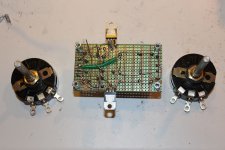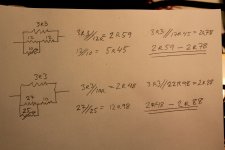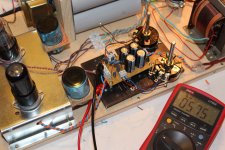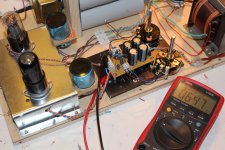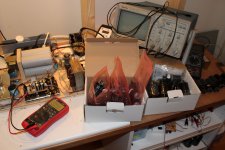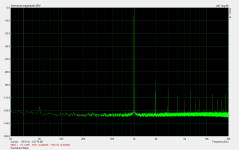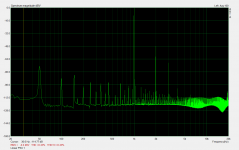How bout a quick rundown of advantages/disadvantages of each. If its negligible or too of topic, I understand.
besides soft on , which option to choose - in my case that depends mostly of my mood and availability of HV big cans
whatever all they say - with or without proper shunt reg , nothing can replace big reservoirs ; of course - (speaking of lower current level stages) proper reg ditto anodes is conditio sine qua non , if you want ultimate results ; usually decent motor run cap is inherent part of shunt reg
for example of higher current level stages - observe VTL approach - big cans , big iron , SS rectifiers
whatever all they say - with or without proper shunt reg , nothing can replace big reservoirs ; of course - (speaking of lower current level stages) proper reg ditto anodes is conditio sine qua non , if you want ultimate results ; usually decent motor run cap is inherent part of shunt reg
for example of higher current level stages - observe VTL approach - big cans , big iron , SS rectifiers
My question wasn´t to choose between SS or tube rectifier but why so many choose a real basic SS diode an then add all kinds of snubbing to compensate for a bad start.
Choosing a modern fast soft recovery diode doesn´t cost an arm and a leg today.
And i agree that different needs call for different solutions that´s not what puzzles me.
Choosing a modern fast soft recovery diode doesn´t cost an arm and a leg today.
And i agree that different needs call for different solutions that´s not what puzzles me.
Hello snubber lovers!
So, I secretly met up with the man with the goldmine again exchanging goods in a secret place. A pair of 25R pots. We shall se where that gets us. Attatching my calcs. My goal is a larger span, yet a fairly safe circuit if the pots for some reason would go south. Any objections, red cards etc hand them out now cause the iron is warm.
So, I secretly met up with the man with the goldmine again exchanging goods in a secret place. A pair of 25R pots. We shall se where that gets us. Attatching my calcs. My goal is a larger span, yet a fairly safe circuit if the pots for some reason would go south. Any objections, red cards etc hand them out now cause the iron is warm.
Attachments
Damper after bridge
Hey BAS,
I may try your PS. I always wanted to try a 6CJ3 after an MUR bridge in my international Loesch style preamp - I even went so far as to buy the 6.3V XF but it sounds so good as is I never tried it.
But after 9 or so years I want to try something different.
Mike
Hey BAS,
I may try your PS. I always wanted to try a 6CJ3 after an MUR bridge in my international Loesch style preamp - I even went so far as to buy the 6.3V XF but it sounds so good as is I never tried it.
But after 9 or so years I want to try something different.
Mike
Ok, I tested the circuit (the lower on the above handscetched photo with calculations and 25 ohm pots) and it does the job very well. I tested a little more then a dozen different ones, RCA, Sylvania, Philips, KenRad, Ferranti, Haltron, JAN, SER, Tungsram, 6P6S, cocebottles, steelcans etc, different in age, measures, construction and they can all be set to a nice choosen level. They start usually around 5,5-5,7 volts and can be screwed up well beyond 6,3, which I avoided.
So I think this is going to be my setup for later build. If it tests ok that is. Thats the next part.
Thanks for help, you who assisted🙂
/Staffan
So I think this is going to be my setup for later build. If it tests ok that is. Thats the next part.
Thanks for help, you who assisted🙂
/Staffan
Attachments
1N5342BRLG ON Semiconductor | Mouser
And I also found small bucks ww-rotarys. This is Conrad http://www.conrad.se/websale7/?Ctx=...t_index=SHOP_AREA_17440_0241750&otp1=tablink2
And I also found small bucks ww-rotarys. This is Conrad http://www.conrad.se/websale7/?Ctx=...t_index=SHOP_AREA_17440_0241750&otp1=tablink2
Last edited:
Just put a note in for the quality of the 6v6 preamp. For grins and giggles I just rebuilt my Conrad Johnson PV-7. The PV7 sounds good but doesn't even come close to the 6V6. The pv7 is dry and not as dynamic as the 6V6. The soundstage is also quite a bit more compressed. I can't wait to go back to the 6V6 later tonight
Hmm too many in there, it will be costly. That guy went for basic Mundorf for instance: Pete Conrad Johnson PV-7 Preamplifier Repaired and Restored - YouTube Which are no better than SCR. Maybe the new EVO Aluminum OIL could do better, still rather economically.
Think I will pop in some output coupling caps at some point in the near future. Not going to spend a ton of money on it as I think that it would be hard pressed to match the naturalness of the 6V6. Don't get me wrong the pv7 is nice, and a good commercial design, but not in the same league. It will be interesting to measure it.
Hi
Next thing for me will be to figure out what things affects microphonics and how to avoid them. Heres two movies, first with Philips tubes, then RCA Black Anodes, showing me tapping my finger gently to the grounded sub chassie.
http://youtu.be/2l5dbjI6DBU
http://youtu.be/8oh7lHsO5qM
Filaments are slightly starved in both example and I am well aware of that some things on the curve is because of long probe groundclips and EMI. Both examples 340 V B+, 5 k anode load common cathode. 2 mV and 10 mS. Probe are on output after 1 uF and the groundclip on other side of the 10M output resistor. Yet no regulation, but a fairly (under 1 mV) clean B+
/Staffan
Next thing for me will be to figure out what things affects microphonics and how to avoid them. Heres two movies, first with Philips tubes, then RCA Black Anodes, showing me tapping my finger gently to the grounded sub chassie.
http://youtu.be/2l5dbjI6DBU
http://youtu.be/8oh7lHsO5qM
Filaments are slightly starved in both example and I am well aware of that some things on the curve is because of long probe groundclips and EMI. Both examples 340 V B+, 5 k anode load common cathode. 2 mV and 10 mS. Probe are on output after 1 uF and the groundclip on other side of the 10M output resistor. Yet no regulation, but a fairly (under 1 mV) clean B+
/Staffan
Last edited:
If you manage to get it tap proof please let me in on the secret 😀.
😀
Well, its not that I intend to use the tubes as maraccas when I play music on it but I beleave that doing most I can to avoid feedback is good for the final result. As far as I understand builders have had quite different experiences with microphony, and I would like to know some on the affecting factors. Of course its chassie design, stable sockets, firm components, tube differences isolated sub chassie etc but it can also be filament and anodevoltage effects.
Some measurments never hurt😉
Last edited:
A near dead silent 340 V B+ 5k, linear PSU anodefollower is playing since a few days now. It added some brute horsepower to my little 11 w EL84 PP. Sisters of Mercy is moving the walls at just over half log pot🙂.
I had some busy days with other stuff but I will see if I can regulate it to and maybe try choke loaded anodes.
Strangely enough, tho its quiet in the speakers, no 50 or 100 Hz there, it measures worse then my humming cathode followers. I used the pot to level it to around zero gain for soundcard measuring.
I had some busy days with other stuff but I will see if I can regulate it to and maybe try choke loaded anodes.
Strangely enough, tho its quiet in the speakers, no 50 or 100 Hz there, it measures worse then my humming cathode followers. I used the pot to level it to around zero gain for soundcard measuring.
Attachments
Last edited:
- Home
- Amplifiers
- Tubes / Valves
- 6V6 line preamp
